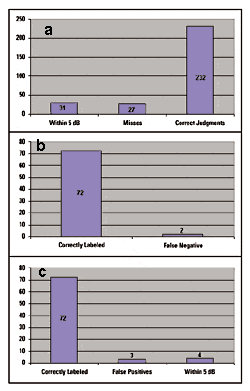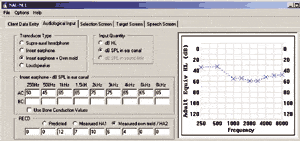In developing a marketing plan for a hearing care business, it should be obvious that there is no one fixed ideal marketing strategy. Indeed, what may work well once, twice, or more times will eventually have a reduced impact. It is therefore vital for any business to develop a dynamic marketing program that uses a mix of advertising and set goals, and then carefully monitor the performance of the marketing plan so it can be modified accordingly.
The traditional means of marketing a hearing care business/practice fall into three broad categories: 1) Prospects (potential clients) generated by mass media; 2) Prospects generated by a referral system, and 3) Professional referrals.
The first category refers primarily to the conventional forms of advertising, such as newspaper, radio, television, telephone marketing, direct (bulk) mail advertising, as well as Yellow Page advertising. The intent of this advertising is to convey your message to everyone—or as many people as possible—in your market area. While necessary for the growth of any business, these types of referrals are fairly expensive relative to the number of “hits” obtained, and it’s essential to have a dedicated leads tracking system in place for assessing the effectiveness of these marketing efforts.
The second advertising category entails referrals generated by current patients. Patient referrals are come by either passive or by active methods. The passive method can be summarized as, “Do a good job and the people will come to you.” Active methods for obtaining patient referrals range from battery clubs, cleaning reminders, birthday wishes, to sales/promotions and open houses. Like the mass marketing category, a mix of these methods is essential.
Professional Referrals
Professional referrals not only consist of physician referrals, but also those referrals obtained from speech pathologists, schools, visiting nurses, nursing homes, as well as from many other sources. These types of referrals are extremely cost effective. For relatively little investment you can get a great return on the small amount of time and money expended in building professional working relationships.
There have been several excellent articles in HR and in other media relative to securing the trust and referrals of doctors and other medical professionals.1-4 Once a professional relationship is secured, the actual prospects/patients obtained in this manner come to your practice with a great deal of trust already bestowed on you. Your decisions are valued because the professional referring you is trusted.
One major problem with relying on referral sources is that most do not routinely screen for hearing problems. Typically, hearing screening is not a part of examinations by doctors, nurses, nursing homes, etc. Patients with hearing loss must exhibit severe-to-profound hearing loss before many of these professionals will recognize that they should be screened and/or referred to a hearing care professional. Professional sources who don’t have a hearing-screening program in place will, at best, be an infrequent referral source of patients.
In the author’s opinion, the hearing screening programs that are currently available to medical/professional referral sources can be placed into three broad categories: 1) useless; 2) too general, or 3) too expensive. Falling under the useless category are tests such as the age-old “Whisper” test, the “Watch-Ticking” test, as well an assortment of other “homegrown” tests that have little reliability and/or repeatability. The too-general category includes the many written hearing surveys, as well as perhaps some of the telephone hearing tests. This is not to imply that these tests are useless; on the contrary, they are very helpful to those consumers seeking to confirm suspicions about their hearing problems (eg, via the Internet or telephone) and the promulgation of these tests should be encouraged. However, these tools are underutilized by physicians and have limited specificity relative to the hearing loss (eg, mild vs. severe, high vs. low frequency, etc).
At present, only audiometer-type screening devices have proven to be effective tools for professional referral sources. However, the cost of purchasing these devices, as well as the costs associated with personnel training and time allotment, places into question their “cost efficiency.” It is widely agreed that these types of devices are terribly underutilized by primary care physicians, family doctors, and other important professional referral sources.
A New Screening Test
The Comparative Hearing Test (CHT) is a recorded CD designed to provide hearing screening via a personal computer or any CD player. Therefore, most facilities will need no special equipment to administer the test. The recorded test stimuli consist of a two-syllable word list, as well as frequencies at 500 Hz, 1 kHz, 2 kHz, 4 kHz, and 8 kHz (Figure 1). The CD also allows for recording, printing, and graphically displaying the results of the test (Figures 2-3).

Figure 1. Test stimuli are accessed on this screen by the patient and the information is recorded by the software. |

Figure 2. Screen showing the data summary, which can then be printed. |

Figure 3. The screener displays a typical high frequency hearing loss onto an audiogram of speech sounds. |

The development of this screener is based on the premise that individuals with normal hearing sensitivity should be able to judge the hearing ability of others by comparing their own hearing to that of the person being tested. Additionally, this person should be able to categorize the degree of hearing sensitivity into normal, mild, moderate, or severe levels using a set of predefined definitions for those hearing levels (Figure 4).
Field Trial
The CHT was evaluated at three separate sites, two sites with audiologists and one site with a hearing instrument specialist. The audiologic evaluations were conducted with calibrated audiometers and sound-treated test booths. No special acoustic considerations were taken when doing the screening test, and all three sites performed the test in soundfield.
A total of 50 patients from the three sites were evaluated. In total, 290 loudness judgments, 250 tonal, and 40 SRTs were performed using the screening test. All 290 judgments were compared to best-ear audiology test findings.

Eighty percent of the loudness judgments (232 samples) were correctly labeled when compared to the corresponding audiologic tests (Figure 5a). Thirty-one of the 58 judgment misses (53%) were audiologically found to be within 5 dBHL of the correct descriptor (eg, a 55 dBHL was judged to be a severe loss or 60 dBHL was judged a moderate hearing loss).
Computation of the false negative and false positive rates provides a clear picture of the effectiveness of the screening tool. False negatives are loudness judgments that are labeled by the screening device as normal but audiologically are found to be a hearing loss. False positives are loudness judgments which are labeled by the screening device as some degree of hearing loss but in fact were found to be within normal hearing.
From a total of 74 loudness judgments labeled as normal hearing, 72 were correct (Figure 5b). Therefore, the false negative rate was 2.7%—or 97.3% were labeled normal and were audiologically found to be within the normal hearing range. A total of 79 loudness judgments should have been assessed as normal hearing. As mentioned previously, 72 were correctly labeled. The seven loudness judgments (8.9%) which should have been labeled as normal were, in fact, labeled as a mild hearing loss.
The 2.7% false negative rate was attributable to one patient who couldn’t differentiate two tones from his tinnitus. However, this same patient failed the CHT screening at other test frequencies and therefore would have been referred for further audiologic testing. The 8.9% false positive rate was the result of seven mislabeled normals (Figure 5c), all judged to be mild losses. Four of these seven tonal judgments were found to have audiological thresholds at 20 dBHL, which many would consider to be a slight hearing loss.
Summary
There are estimated to be over 28 million Americans with significant hearing loss. As a hearing care professional, you would like to think that anyone with a hearing loss would recognize their problem and seek help from you. As a realist, you know better. Most people turn to their family doctor, visiting nurse, nursing home staff, etc. Thus, professional referrals obtained from these sources are a vital component in the overall hearing health care continuum, as well as the marketing programs of hearing care professionals. However, until physicians and care givers take an active role in screening hearing, referrals from these sources will be few.
The dilemma has been that screening tools and devices have either been inexpensive but uninformative, or not specific enough relative to the hearing loss, or quite informative but too costly to be used as a widespread screening tool. In addition, for any screener to obtain widespread acceptability, it should have a relatively high degree of accuracy, reliability, low cost, speed, and user friendliness (ie, not requiring hours of training).
The data from this field study focused on the accuracy issue, and the results suggest that the CHT can be used as an accurate tool. While the other features that make up a good screening instrument (eg, speed, reliability, low cost, and ease of use) were not directly tested during this study, they formed the basis of the product’s initial design criteria. CD technology was chosen because it is inexpensive, reliable, fast, and almost universally accessible.
The CHT is also designed for easy use and interpretation. When using a PC, the patient’s screening results are graphically superimposed onto an audiogram of speech sounds. For example, a graphic display (Figure 3) can reveal to both the tester and patient why it is the subject can “hear but not understand speech.” Likewise, this feature helps put the professional using the screening tool into the “treatment loop.”
| This article was submitted to HR by James M. O’Day, AuD, a private practice audiologist working in the New Hampshire seacoast region since 1986. Correspondence can be addressed to HR or James M. O’Day, AuD, Hearing Aids and Eyewear Center, 165 Charles St., Ste. 10, Rochester, NH 03867; Web site: www.comparativehearingtest.com; email: [email protected]. |
References
1. Sanford M, Kirkhaefer B. Lunch and learn: Private practice marketing to physicians. Hearing Review. 2001; 8(10):28-30.
2. Van Houten B. BHI pursues physician referrals with innovative new program. Hearing Review. 2002; 9(2):26-28, 60.
3. Whichard S. Gaining referrals through a physician marketing program. Hearing Review. 1998; 5(11):12-16.
4. Dunn H, Dunn D, Harford E. Audiology Business and Practice Management. San Diego: Singular Publishing; 1995.





